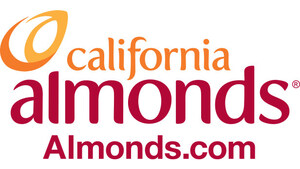Celebrate National Almond Day With A Heart-Smart Handful Of Almonds
MODESTO, Calif., Jan. 31, 2013 /PRNewswire/ -- February is American Heart Month and also National Snacking Month. How are these two related? Smack in the middle of the month on February 16 is National Almond Day, celebrating the crunchy heart-smart snack.
It's no wonder there's a whole month dedicated to the love of snacking: according to recent surveys, North Americans snack about twice a day on average,1 and more than 50 percent consumed snacks between 2 p.m. and 5 p.m., when people hit that afternoon slump that can make anyone listless or irritable from hunger.2
You will never go "hangry" again if you stash a handful of heart-healthy almonds in your purse or gym bag. What's more, the Almond Board of California is having a sale on reusable, take-with-you almond tins through the end of the month – just $1 each. The tins – much more stylish and durable than the traditional plastic baggie – hold a perfect one-ounce portion size for nutritious and crunchy snacking on the go.
The nutritional value of almonds has been studied and observed for many years. Two decades of published research to date has shown almonds' nutrient profile supports healthy heart functions, with more studies undertaken to support these findings every year. According to the U.S. Food and Drug Administration, "Scientific evidence suggests, but does not prove, that eating 1.5 ounces per day of most nuts, such as almonds, as part of a diet low in saturated fat and cholesterol may reduce the risk of heart disease."
Further research demonstrates that the nutritional profile of almonds may be beneficial to a healthy lifestyle:
- According to a survey of 500 health professionals, almonds are the nut health professionals most recommend for heart health benefits.3
- Recent research from Purdue University suggests that eating almonds can help people feel satisfied for several hours, which can support weight management and counter weight gain.4
- While the Nutrition Facts Panel states almonds have 160 calories per ounce, the results of a recent study using a new method to calculate calories shows that whole almonds may have 129 calories per ounce. The study, which takes into account the digestibility of whole almonds, was conducted by scientists from the United States Department of Agriculture (USDA) and released in the August 2012 issue of the American Journal of Clinical Nutrition (AJCN). 5 Further research is needed to better understand the results of the study and how this technique for calculating calories could potentially affect the calorie count of other foods.
Don't be fooled by the small package; almonds pack a lot of nutrition into each handful. Naturally cholesterol-free, almonds are the tree nut highest in fiber (3.5g) and protein (6g) and contain 13 grams of unsaturated fat and only one gram of saturated fat per one-ounce serving. When compared ounce for ounce, almonds are also the tree nut highest in calcium, vitamin E, riboflavin and niacin.
Almonds come in many forms and flavors making the snacking options nearly endless. Here are some easy ways to incorporate almonds in your day:
- Mix an equal portion of whole natural almonds, raisins, and banana chips for a quick and easy trail mix at your desk or in the car.
- Sandwich almond butter between two apple halves for protein and a serving of fruit on the go.
- Try bringing almond snack mixes, like Rosemary Almonds, Almonds Mocha, or Basil Pesto Almonds, to your next party instead of wine – your host will enjoy the flavor variety, and guests will have a delicious snack to munch.
For more nutrition information and recipes for National Almond Day, National Snacking Month and American Heart Month, visit www.AlmondBoard.com.
About Almond Board of California
Consumers all over the world enjoy California Almonds as a natural, wholesome and quality food product, making almonds California's leading agricultural export in terms of value. The Almond Board of California promotes almonds through its research-based approach to all aspects of marketing, farming and production on behalf of the more than 6,000 California Almond growers and processors, many of whom are multi-generational family operations. Established in 1950 and based in Modesto, California, the Almond Board of California is a non-profit organization that administers a grower-enacted Federal Marketing Order under the supervision of the United States Department of Agriculture. For more information on the Almond Board of California or almonds, visit AlmondBoard.com.
1 Sterling Rice Group. North American Consumer Qualitative Study, April 2009.
2 Late Night Snacking Popular in the US. January 4, 2013. http://www.foodnavigator-usa.com/Market/Late-night-snacking-popular-in-the-US?utm_source=copyright&utm_medium=OnSite&utm_campaign=copyright
3 Sterling Rice Group, 2011 North American AAU, July 2011, page 28.
4 Cassady, B.A., J.H. Hollis, A.D. Fulford, R.V. Considine, R.D. Mattes. 2009. Mastication of almonds: effects of lipid bioaccessibility, appetite, and hormone response. Am. J. Clin. Nutr. 89:794-800.
5 Novotny JA, Gebauer SK, Baer DJ. Discrepancy between the Atwater factor predicted and empirically measured energy values of almonds in human diets. American Journal of Clinical Nutrition. 2012 ajcn.035782; First published online July 3, 2012.doi:10.3945/ajcn.112.035782
SOURCE Almond Board of California
WANT YOUR COMPANY'S NEWS FEATURED ON PRNEWSWIRE.COM?
Newsrooms &
Influencers
Digital Media
Outlets
Journalists
Opted In






Share this article